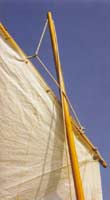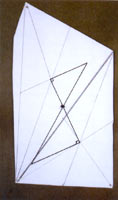|
Book Review |

|
The Working Guide
to Traditional
Small-Boat Sails
A How-To
Handbook for Builders and Owners
by David L. Nichols
In my fantasy life, I’m such a well-known nautical
personality that publishers flood me with advance
copies of sailing books, looking for those clever,
pithy quotes to plaster on the dust jacket.
Alas, as in so many things, reality is well short
of fantasy (“You got that right, buster,”
my wife is quick to chip in). But when Chuck Leinweber
sent along a copy of David L. Nichols’ book,
“The
Working Guide to Traditional Small-Boat Sails, A How-to
Book for Builders and Owners,”
it seemed appropriate to indulge fantasy and pretend
the publisher had asked me for some blurbs.
An interesting way to
attach a lug yard to the mast.
(click images to enlarge)
|

|
|
For this book, they just seem to roll off the keyboard.
Such as: “This is a concise and thorough compendium
on using low-cost and efficient traditional rigs,
the kind that not only look better but work better
on small boats than their modern counterparts.”
Or this one, geared for Duckworks readers: “Shorty
would reach for this book when he decides to put a
sliding gunter on a PD Racer, or Rob would grab it
when he wants to redo his Light Scooner with a balanced
lug foresail and sprit main.” Or my favorite:
“This will become the classic book on traditional
rigs for small boats.”
You may have deduced that I really like this book.
You’re right!
Published by Breakaway Books and only 96 pages long,
Nichols has packed an amazing amount of information
into this well-illustrated volume.
It starts with the basics of sail shape, covers
fundamentals of marlinspike skills (I lust after the
rigging knife shown in one picture), and then has
an excellent chapter that explains how to figure where
the mast(s) and sail(s) should be located in a boat,
whether starting from scratch or retrofitting a traditional
rig on an existing hull. Then it proceeds with separate
chapters on the sliding gunter, sprit, standing and
balanced lugs, Chinese lug, and gaff rig. A final
chapter looks at esoteric variations for some rigs
and unusual rigs.
Although I have been sailing for almost 30 years
(including stayed sloop, lateen, sprit, gaff, and
dipping and balanced lugs) and have read hundreds
of books, it seemed like I was learning something
new at every turn of a page.
For example, in Chapter One, I knew that draft in
a sail produces its drive and that the ratio of the
depth of the draft to the length of the sail is called
its chord. But did you know that the chord of most
sails falls in range of 1:10 (one foot of draft for
every 10 foot of length) and 1:13, with 1:10 being
considered on the “full” side and 1:13
being consider on the “flat” side? I didn’t
either.
Chapter Two shows how to whip a line, seize a line
around a thimble, and do an eye splice in three-strand
line. Whipping and seizing involve wrapping twine
tightly around rope and can be rough on the bare hands.
Nichols eases the pain by revealing (also unknown
to me) that there are two types of sailor’s
sewing palms. The more common is the seaming palm.
But there is also a roping palm that has a hard ear
over the thumb that allows the twine to be carried
over it and tension applied without tearing up your
hands. It’s now high on my list of desired gear.
And so it goes, chapter after chapter, as Nichols
looks at the various traditional rigs. The sprit rig
is a model of simplicity with one mast and one peak
sprit. But some sailors want to add a boom. Nichols
shows several variations and also discusses the pros
and cons of the change. (One of the book’s many
strengths; Nichols always gives the advantage and
disadvantage of any rig, rigging or variation.)
Figuring out the center of effort for a Chinese
lug defies the commonly used methods because of the
sail’s odd shape. Nichols shows you how to do
it. Don’t want to use a traditional beaded parrel
on your lug sail yard? Nichols has a neat variation
using a line with a thimble (which is one reason in
Chapter Two he shows how to seize a thimble in a line)
and the halyard that tensions itself as the sail is
raised.
 |
Finding
the center of effort of a Chinese lug
can be difficult because of the odd shape,
but Nichols provides step-by-step guidance.
|
|
And we’ve barely touched the rigging nuggets
waiting to be mined.
Much of the high accomplishment of this book is due
to the amount of information Nichols was able to pack
in such a modest length. His writing is economical,
straightforward, and easy to follow. Combined with
a generous number of high-quality color photographs
and black-and-white drawings, it makes the book and
its information easy to follow.
There is no bibliography, but throughout, Nichols
does a good job of citing other sources where an interested
reader can find more information. (Both he and I are
admirers of Hervey Garrett Smith’s writings
– and Heaven knows Smith probably mentioned
the roping palm somewhere and I missed it.)
| A pience of
gear I never hear of, this roping palm with
the hard ear on the thumb is a big help
for painless whipping and seizing |

|
|
It’s also important to know what this book
is not. It is not a bible with all possible information
and permutations covered. It does not give you scantlings
for a mast, yard, and boom for, say, a 150-square
foot gaff sail, or for the spars for an 80-square-foot
sprit sail. That’s not its purpose. As the title
says, it’s a handbook. It will show you the
variations of rigs available for your small boat and
should allow you to figure out which one you want
and where it should go in your hull. I suspect most
readers of this book would already know what the spar
scantlings should be, or where to find that information.
Others can consult the sources given by Nichols.
I like this book because it is not overloaded with
such minutiae. It is fact packed, interesting, well
illustrated and a good read. Consequently, for my
money, it’s the first book someone looking into
traditional rigs should consult.
Having said that, there are a couple points to be
made.
One is that throughout the book, Nichols refers to
the normal stayed Marconi-style sails that populate
production boats as the “Bermudian” rig.
Most authorities call it the “Bermudan”
rig. (I know, I know, talk about nitpicking . . .
.)
The second comes from Nichols chapter on locating
masts and sails. If you have done much reading, you
know this involves figuring out where the center of
effort (COE) of the sail or sails are and placing
that in relationship to the underwater center of lateral
resistance (CLR). Some designers hold that locating
the COE just aft of the CLR produces the desirable
slight weather helm for sailboats. Nichols calls for
locating the COE five to 10 percent of the waterline
length in front of the CLR. In his essay on the subject,
boat designer Jim Michalak notes in his leeboard boats
he usually places the COE slightly behind the CLR,
but adds that for fin keel boats some designers have
the COE forward of CLR. I’m not the expert to
sort this out, but merely want to note the discrepancy
for the reader. And it’s also good to listen
to Nichols’ comments on locating a rig, where
he notes there are other factors that affect balance,
including weight and location of crew and gear.
“Finding the balance for a sailboat is really
a compromise of various factors that are in a constant
state of change, and allowing for some adjustment
once the boat is launched is very important,”
Nichols writes. “If this is done, then the process
will be a satisfying and successful change.”
Like everything else in “The Working Guide
to Traditional Small-Boat Sails,” it’s
sound advice.

Other articles by Gary Blankenship & Helen Snell:

|